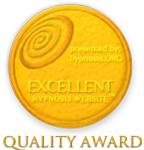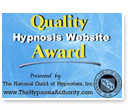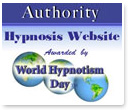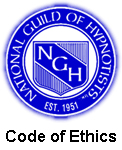5-PATH®: Five Phase Advanced Transformational Hypnosis™ Overview
5-PATH®: The First Truly Powerful Systematic Approach to Hypnosis
Calvin D. Banyan, MA, BCH, CI
Learn About 5-PATH® using Age Regressions, Forgiveness Works and Parts Mediation Work
5-PATH® is an acronym for the true name of the process, Five-Phase Advanced Transformational Hypnosis™.
In it I blend the best of psychology and hypnosis.
- Proven principles from the science of psychology
- The most powerful hypnotic techniques and processes
- Reliable and effective approach validated around the world.
- Makes it easy to select the most highly trained and qualified hypnosis professionals
The roots of 5-PATH® can be traced back to the best known in psychology, medicine and professional hypnotism, including its earliest influences, the "Father of Hypnotism", Dr. Franz Anton Mesmer, as well as one of the greatest pioneers in the science of psychology such as Dr. Ivan Pavlov. In more modern times we have the psychological scientist, Dr. B. F. Skinner, as well as the renowned hypnotists, Dave Elman, Harry Arons, Gil Boyne, Charles Tebbits, Gerald F. Kein, and others, the former all well known in the science of psychology, and the latter in the profession of hypnotism.
Up until recently, the use of hypnosis for helping people attain their goals was divided among two camps, those in the medical/psychological professions, and those who specialized in hypnosis. I started out in the first group and now live more productively in the second. Now after conducting thousands of sessions, and supervising those who have conducted thousands more, I am confident in saying that 5-PATH® is the most advanced system of hypnotism for personal change in the world.
5-PATH® is special because it incorporates the most powerful tools available to the modern hypnosis professional and arranges them in such a way as to increase the effectiveness of each component of the system. It is an optimization of what works, and it is criteria based. That is, the hypnotist using the system is able to apply these advanced hypnotic techniques to a wide variety of issues. This increases both the effectiveness of the hypnotic tool, and also its reliability.
This means that each client is able to get more results more quickly than any other system. In fact, as far as I know, there is no other recognized system of hypnosis.
5-PATH® is the only system of hypnotism ever recognized by the National Guild of Hypnotists, and has been officially installed as a Special Interest Group by that world-wide organization of over 10,000 members.
Since this is a system, and can be taught, supervised, evaluated, and contributed to by others, it is an ever improving system, which has been tested and the results validated. Literally thousands of people around the world have benefited by working with 5-PATH® Certified Hypnotists. These highly trained hypnosis professionals are among the most highly trained and qualified hypnotists in the world.
No hypnotist who has ever trained in 5-PATH® would ever settle for anything less than 5-PATH® when seeking hypnosis services for either him or herself, or a member of their families. They know that 5-PATH® trained hypnotists get results when others do not.
History
After conducting research into hypnotic techniques, I was struck by the need to develop a systematic and virtually universal approach. I wanted to train the hypnotists at The Hypnosis Center, Inc, in a system that was relatively easy to learn, and easy to supervise. And, foremost, it had to be a system that provided good consistent results.
I was most impressed with the techniques that I learned from Gerald Kein at The Omni Hypnosis Training Center, in Deland, Florida.
Among the most important ideas and techniques that I learned were:
The need to properly prepare the client by sending a positive message, implying success from the very first contact, i.e., responding to questions about services with, "Yes, we do that all the time!"
The need to do a good pre-talk, where you focus on educating the client, and removing fears and misconceptions.
Using an appropriate hypnotic induction, usually a rapid or instant induction.
Utilizing a hidden test for somnambulism.
Using convincers, compounding of suggestions and direct drive techniques.
Using age regression to find the events that started the problem, using affect bridge.
Using informed child technique to change the effect (emotional or beliefs regarding incident).
Using the principle of forgiveness in work for others and the client.
Using Parts Work.
Using appropriate touch, to enhance the work.
These techniques and ideas were then organized into a systematic procedure that enhances each of the procedures as a whole, thus improving the outcome.
Basically, Here Is How It Works
The hypnotist will take the client through the following phases, each improving the success of the the subsequent phase (called a phase because more than one session may be necessary for procedure):
Direct Suggestion with Convincers
Age Regression and Informed Child Technique
Forgiveness of Others Work
Forgiveness of Self Work
Parts Mediation Work
How this is done is briefly outlined and explained below.
Before the Hypnosis Session
The hypnotist needs to be aware of the principles of waking suggestion, and how the client's degree of success is in part determined by events that occur before the "hypnosis session" begins. The client's success is greatly increased if you are mindful of how the client is handled prior to the session. All of the following have an effect on the work you will be doing with the client.
Everything she has ever heard about hypnosis and you.
Your appearance and your office's appearance.
Any statements that you make about hypnosis or expected outcome.
Because of this you will need to make statements suggesting an expectation of a positive outcome. You and your office must be consistent with the message you intend to send (i.e., professional). You must do a good pre-hypnosis presentation, including a pre-talk and intake.
Then begins the five phases.
Phase I - Preparation, Testing and Convincing
The focus of this phase of hypnosis is to have the client have a successful session. To accomplish this, the 5-PATH®system consists of the following in Phase I:
Proper induction -- usually an instant or rapid induction.
Use of a hidden test for somnambulism.
Deepening.
Use of convincers--so that the client knows that she was hypnotized (i.e., eye lock).
Installation of suggestions for future success when doing hypnosis (i.e., post-hypnotic suggestion for rapid re-induction of hypnosis in future sessions).
Use of Direct Suggestion techniques, including giving some suggestions that were checked out with the client a head of time, in the pre-hypnosis interview (this puts the client at ease), giving suggestions appropriate to the issue, including the use of Compounding and Direct Drive techniques.
Making additional suggestions during the emerging process for post hypnotic suggestion (more convincers), such as time distortion and sensitivity to a color such as red.
Running a first session this way is done for the following reasons:
Using all of the above will improve the probability of a successful Direct Suggestion session.
Instill confidence in the client that she can use hypnosis for the issue she wants to work on.
Instill confidence in the client that she has selected a good hypnotist.
And, even more importantly perhaps, you have turned this person into an ideal client that will be great to work with in the future. This client, having gone through this procedure, will almost certainly experience a true Age Regression session (Phase II) with revivification.
Phase II - Age Regression
Every problem that our clients come to see us about, have an origin, a beginning. The use of Age Regression Work is probably the most powerful tool available to a properly trained hypnotist. It is an essential part of 5-PATH®. In addition to uncovering information from the past that might have become unavailable to the conscious mind, regression allows the hypnotist to "undo" the effects of the incident or incidents that have formed the problem. It is so important, that much of what was done in Phase I, was done so that we can have a successful Age Regression Session nearly every time.
It would go like this:
Use post-hypnotic suggestion for rapid re-induction of hypnosis to somnambulism.
Deepen.
Use Affect Bridge (usually).
Find ISE (initial sensitizing event).
Use Informed Child Technique.
Use Informed Adult Technique.
Progress into the future to experience success for the issue.
Use direct suggestion after change has been made.
Emerge, using suggestions for success.
The 5-PATH® practitioner is encouraged to focus on the use of suggestion here. Remember that after you have accomplished Age Regression and Informed Child, the subconscious mind has been forced into a state of reorganization. Prior to this, the subconscious mind may have been resistant to suggestion, but now it is in a state of heightened suggestibility beyond what can be accomplished where Direct Suggestion techniques alone could accomplish.
Age Regression has now, increased our probability of success, even further because it has probably uncovered new information and provided additional insight, that both the client and hypnotist can use, as we continue into Phase III.
Phase III - Forgiveness of Others
The Age Regression session (Phase III) has provided us with great opportunities. The impact of the clients ISEs and SSE have been removed or reduced. You and the client have a much better understanding of the history of the problem/issue. And, most importantly to this phase, we know who the players are. We know about the people in our client's life that have been a part of the problem. In addition to gaining insight, and perhaps having been desensitized, the problem can be further healed by using forgiveness techniques. This provides for a reduction in emotion regarding the problem and a more complete releasing of the past, including the problem/issue.
It would go like this:
Do induction and deepening.
Set up for "Chair Work" where the client can confront or communicate with the person who was the contributor to the problem, i.e., abuser, parent, rapist, etc.
The situation is made so that the client will be completely safe in expressing her feelings (i.e., the offender cannot get out of a chair, etc.).
The client is encouraged to express how she feels or felt about what happened. The client is greatly encouraged to really let it all out.
Once the client is exhausted, the hypnotist has the client take the place of the offender, and will speak from that perspective.
Hypnotist then goes after the offender, similar to how the client did, but perhaps even stronger.
-
This will often cause new insight in the client with regard to the situation to occur which will be useful in accomplishing the forgiveness.
Dialog is encouraged between the client and the offender (the client will speak from both perspectives)
-
The client is then guided into forgiving the offender. It is explained to the client that this is for her own benefit and not for the benefit of the offender.
Then additional Direct Suggestion techniques are used, regarding the problem/issue.
This process of forgiveness may be repeated for additional players who contributed to the problem. And, the client may be encouraged to continue to forgive less significant persons on her own for a period during the session.
Notice the use of suggestion at the end of the process. Again, I want to remind the hypnotist that powerful techniques such as this force the subconscious mind into reorganization, and the client become exceptionally suggestible for suggestions that are consistent with the experience. Don't overlook this opportunity!
This phase again set us up for increased success in the following phase.
Phase IV - Self-Forgiveness
Most of my clients report that this phase of forgiving herself was the most important. I often wish that I could just go here first. But I believe that this phase is so successful because of the work done in the preceding phases.
It is essentially the same as Phase III, except this time the client take on two roles. The first role will be that of the "Self" and the other is the "Mistake-Making-Part." The Mistake-Making-Part, takes on the part of the offender in Phase III. This approach allows the client to see herself in a more detached and objective way.
It goes like this:
Do induction and deepening.
Set up for "Chair Work" where the client can confront or communicate with the Mistake-Making-Part, who will be blamed for every mistake she has ever made in her life.
The situation is set up so that the client will be completely safe in expressing her feelings toward the Mistake-Making-Part.
The client is encouraged to express how she feels or felt about the mistakes made in her life. The client is greatly encourage to really let it all out.
Once the client is exhausted, the hypnotist has the client take the place of the Mistake-Making-Part, and will speak from that perspective. Before that she was speaking from the perspective of the Self.
Hypnotist then goes after the Mistake-Making-Part, similar to how the client did, but perhaps even stronger.
This will often cause new insight in the client with regard to the situation to occur which will be useful in accomplishing the forgiveness of herself.
Dialog is encouraged between the client and the Mistake-Making-Part (the client will speak from both perspectives again)
The client is then guided into forgiving the Mistake-Making-Part. Because of the new insight, about the situation, the Mistake-Making-Part, can be reframed as the Protective Part, also making her more forgivable.
Then additional Direct Suggestion techniques are used, regarding the problem/issue.
This is usually a tremendous experience for the client. By this time in the hypnosis, the problem has been completely resolved/healed. The work is usually done at this point and no further work is required. However, sometimes more work may be needed, because of a special circumstance. This will be addressed in Phase V.
Phase V - Parts Mediation Work
The vast majority of clients do not need this Phase of the work. It is here for a special case. This is the sticky case of the client that will not heal or completely respond to work. This is usually because of Secondary Gain Issues. It must be kept in mind by the enlightened hypnotist that even some of the most painful problems can have benefits! Phase V, is specifically designed to get at this kind of problem.
It is patterned after two procedures, Parts Work and Mediation. Together they become Parts Mediation Work. It differs from Parts Work because it does not focus on descriptive characteristic of the individual such as the Joy Part, or Creative Part, etc. In that kind of work, we are bringing up characteristics or abilities that have been suppressed, lie dormant, or are otherwise out of balance.
In Parts Mediation Work, we utilize the concepts of mediation, where we work toward building agreements between the parts of the self which are in conflict. We uncover issues and focus on a win-win situation. These new agreements include doing more beneficial or healthy behaviors in the future.
The process would go like this:
Induce hypnosis and deepen.
Suggest that you are the mediator and not the judge (mediators are only facilitators).
Bring up the subject of the conflict (the problem/issue that has not been completely resolved).
Suggest that more communication may be in order.
Suggest that there is a part of her that is aware of a benefit of continuing to have the problem.
Find out why the problem is useful.
Name the part, such as The-Still-Wanting-To-Smoke Part.
Have the Self discuss the benefits of making the change.
Uncover and discuss alternative behaviors that will provide the same benefits as the problem behavior.
Discuss other the benefits of changing to the new behavior.
Have both sides come to a win-win agreement where both sides have their needs met.
Do any forgiveness work that needs to be done between the two sides.
Merge the two side back together as one.
Do Direct Suggestion techniques for change.
As usual, the process ends with appropriate suggestions for change. Here we have uncovered the cause of the inability of the client to come to full resolution of the problem. And, we have provided an alternative, but need fulfilling alternative behavior. This is set up as an agreement between the parts. If there is any reluctance between the parts in this intra-psychic mediation, then a trial period can be agreed upon, where a next session can be set up to evaluate the success of the agreement and make any further changes that may be need to encourage ongoing success.
Phase I, is done this way because it greatly increases the probability of success in Phase II, an Age Regression Session.
Summary
This had been a quick overview of 5-PATH® a systematic approach to doing hypnosis, which is almost universally effective in the problems that our clients face. It can be modified to suit the client and application by the hypnotist.
I offer training in this system as part of our National Guild of Hypnotists certification course and also as an advanced training for practicing hypnotists.
If you have further questions about this process please contact me.
© Calvin D. Banyan, The Hypnosis Center, Inc. All Rights Reserved.
Testimonials
"I found 5-PATH®, all that I had hope it would be, plus more." Georgina Edleskon-Cooke (Holland), Montego Bay, Jamaica
"Tops! one of the Best investments I have made. 7th Path™ went way beyond expectations. - 5 PATH® put depth, and clarity to make my hypnosis practice super effective and well consistently yielding excellent results." Kim Bradford Bothwell, USA
"5 PATH® was absolutely terrific! Thanks and well done." Mitch Nielsen, USA
"5-PATH has been a quantum leap in hypnotic possibilities. 7th Path was a surprise, a powerful tool for personal transformation and a wonderful compliment to 5-PATH practice. The power of 7th Path is phenomenal. Cal is an inspirational teacher, it is a joy to be in class." Lynda Panter, D. Hyp, MBSCH, Gosport, UK
"By adding 7th Path to 5-PATH, Cal has created a program where not only do you learn the tools to change others, but by the end of the training you have changed yourself. It's 10 times more powerful than anything else that's out there!" Barry Neale, Ph. D, Essex, UK
"The elegance of the 5-PATH & 7th Path techniques brings together a lot of what I know, together with a lot I wasn't aware of, honed to only that which is most effective. It is inspired and inspiring – as is Calvin Banyan, the creator. The two techniques in concert provide a wonderfully complete and rounded process. It is like being an architect and finding the perfect building materials that won't crack or crumble. Once built, with all the pieces in place, there stands a beautiful structure – able to deal with wind, rain & natural disaster." Helen Craven, MA(RCA), DCH, Kingsland Basin, UK
"A fabulous mixture of the practical and the inspirational. I'd thought there may be more to working with hypnosis, but didn't suspect just how much! I've learned some effective new techniques, but more importantly, a powerful new system with which to help clients. Both 5-PATH and 7th Path will be indispensable in my practice – and 7th Path in my life." Sian Schofield, BA, PGCE, DHP, Manchester, UK
"With the 5-PATH® layout, you can use this technique to clear up just about anything a client comes in for" Chuck Frank, CH, Hypnotist San Diego, CA
"5-PATH® brings the professional level of hypnosis to new and significantly higher standards." Steve Gruber, BS, MA Quebec, CA





